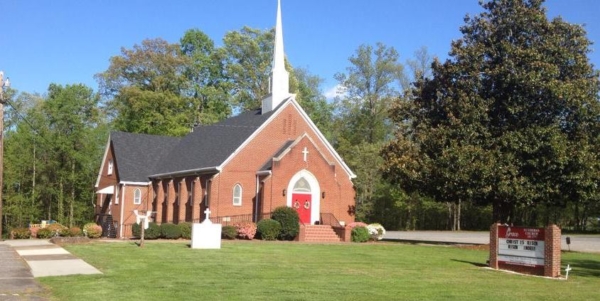 The New Brick Lutheran Church, erected on land on the east side of the highway just opposite the Brick “Union” Church, was opened for service on Easter Day, April 5, 1942. For a number of years faithful pastors had prayed and worked that a peaceful division might be made that each congregation might have its own property and be at liberty to hold services at any time without interfering with the other. During the pastorate of the Rev. B. S. Brown, D.D., the dream of a Lutheran church home came true. The total cost of the building and furnishings was $17,406.03. On June 6, 1943, the building was dedicated. The successful completion of this building program and the prompt payment of all indebtedness was the result the finest kind of cooperation.
The New Brick Lutheran Church, erected on land on the east side of the highway just opposite the Brick “Union” Church, was opened for service on Easter Day, April 5, 1942. For a number of years faithful pastors had prayed and worked that a peaceful division might be made that each congregation might have its own property and be at liberty to hold services at any time without interfering with the other. During the pastorate of the Rev. B. S. Brown, D.D., the dream of a Lutheran church home came true. The total cost of the building and furnishings was $17,406.03. On June 6, 1943, the building was dedicated. The successful completion of this building program and the prompt payment of all indebtedness was the result the finest kind of cooperation.
On an icy Sunday morning, March 7, 1948, about two hours after the furnace had been fired, the electricity went off for over an hour. During that time the fan on the furnace stopped, heat concentrated in the boiler, the boiler dome blew off, and the Brick Lutheran Church was in flames. Before the fire was discovered, the building was a total loss. Even the contents of the cornerstone were destroyed.
Following the policy of the United Lutheran Church in America, the Grace Church Council voted on that day, March 7, 1948, that only Free-Will Giving would be used to rebuild the church edifice.
At a congregational meeting on March 14, 1948, the congregation voted to: 1) to re-build as soon as possible, using the original plans with expansion of the educational plant and expansion of the nave to seat approximately 300 people; 2) To hold all worship services at the Grace Union Church; 3) To have Miss Beulah Heavner serve as treasurer of the Building Fund as she had for the Brick Lutheran Church; and 4) To accept the offer of the P. L. Jarrett family to give the face brick for the new building with the congregation paying for the transportation from Salisbury.
At a congregational meeting on July 25, 1948, it was voted to let Mr. Joseph H. Bolch, Hickory contractor, rebuild Grace Church using the enlarged plans submitted by architect Glenn E. Yount of Newton. It was also voted to transfer the worship services from the Grace Union Church building to Blackburn School building. There was more space for educational purposes and more regular hours for worship services could be followed. Individual Sunday School classes were again held, and the auditorium was transformed into an area for worship services.